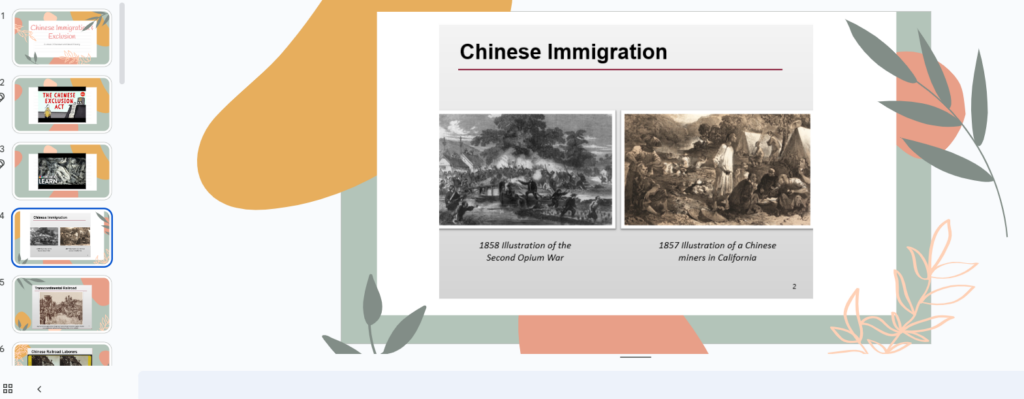Chinese-American History in Northern California
Old Town Eureka, CA and the Chinese Exclusion Act of 1882
Overview and Context
This lesson was created to learn about the Chinese Exclusion Act of 1882 through studying murals in Eureka, Northern California. Although this particular lesson was centered around the history of Chinese Americans in a specific area, the lessons about the Chinese Exclusion Act of 1882—and the consequences that followed—could be applied to other learning contexts for high school-aged students. Students analyze the relationship among the rise of industrialization, large scale rural-to-urban migration, and massive immigration from Southern and Eastern Europe and Asia.
Learning Objectives
Using the Eureka Mural titled “Fowl” as a central art piece, students will then learn about the history of Chinese Americans in the Eureka, Northern California Area and the consequences of the Chinese Exclusion Act.
Assessment
Guided notes and response sheets as well as verbal discussion about the use of a podcast when viewing a piece of artwork.
Resources
- Chinese Immigration and Exclusion: Eureka Chinatown and Local History (Google slides)
- Chinese Immigration and Exclusion guided notes (Google doc)
Step-by-Step Instructional Plan
1. Exploring Background Information
First, students will watch the following clips about Chinese exclusion:
The dark history of the Chinese Exclusion Act – Robert Chang, Ted-ED
The Chinese Exclusion Act, NBC News Learn
Using the Chinese Immigration and Exclusion guided notes, students are told to identify three things they learned or found interesting in the videos. Next, students will read the timeline and write a hypothesis for why Chinese immigration was restricted in 1882.
2. Document Analysis
Second, have students view the Chinese Immigration and Exclusion: Eureka Chinatown and Local History using the Chinese Immigration and Exclusion guided notes again which has questions to guide students through analysis. In addition, using all five documents, students will discuss why Chinese immigration was restricted in 1882.
Document A
- Who wrote this document?
- Who did this organization represent?
- Why might the members of this organization have held these views?
- What evidence does this document provide about why Chinese immigration was restricted in 1882?
Document B
- How might the economic conditions described Doc B have influenced the opinion of the Pioneer Laundry Workers in Doc A?
- Does this document provide evidence about what led to the restriction of Chinese immigration in 1882? Why or why not?
Document C
- What is Pixley’s argument for ending Chinese immigration?
- Where had Pixley been attorney general?
- How might this corroborate information in the timeline?
- Where did Pixley give this testimony?
- What does this suggest about American voters’ opinions about Chinese immigration?
- What evidence does this document provide about why Chinese immigration was restricted in 1882?
Document D
- Who wrote the document?
- How was the author’s perspective different from the authors of the other documents?
- Despite the differences in perspective, how does the author’s letter corroborate Document A?
- How does it corroborate Document C?
- What evidence does this document provide about why Chinese immigration was restricted in 1882?
3. Reflection and Writing
Students will listen to a podcast and write a few sentences reflecting on the podcast, including interesting points of content about the mural and Eureka Chinese History.
Students will also spend some time browsing the Clarke Museum website (local museum website) on Immigration, Expulsion and Homecoming: The Legacy of the Chinese Exclusion in Humboldt County and discuss five interesting facts learned from this resource.
Extensions and/or Enrichment
- The Chinese Expulsion, North Coast Journal
- Chinese Exclusion Act of 1882, National Archives
- Chinese Exclusion, Library of Congress
- The Forgotten History of Purging Chinese from America, The New Yorker



